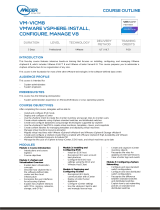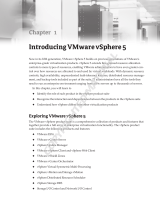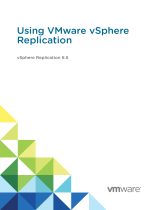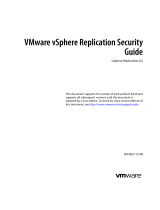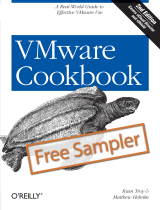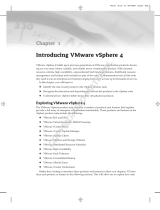Page is loading ...

A Dell Deployment and Configuration Guide
Dell Virtual Storage Manager: Installation
Considerations and Local Data Protection
Virtual Storage Manager (VSM) end-to-end array management, local data protection and
recovery, and VMware vSphere Virtual Volumes (vVols) with Dell PS Series storage
Dell Storage Engineering
November 2019

2 Dell Virtual Storage Manager: Installation Considerations and Local Data Protection | 2079-BP-V-VSM
Revisions
Date
Description
June 2015
Initial release
November 2019
vVols branding update
THIS WHITE PAPER IS FOR INFORMATIONAL PURPOSES ONLY, AND MAY CONTAIN TYPOGRAPHICAL ERRORS AND TECHNICAL INACCURACIES. THE CONTENT IS
PROVIDED AS IS, WITHOUT EXPRESS OR IMPLIED WARRANTIES OF ANY KIND.
© 2015–2019 Dell Inc. All rights reserved. Dell, the DELL logo, and the DELL badge are trademarks of Dell Inc. Other trademarks and trade names may be used in this
document to refer to either the entities claiming the marks and names or their products. Dell disclaims any proprietary interest in the marks and names of others.

3 Dell Virtual Storage Manager: Installation Considerations and Local Data Protection | 2079-BP-V-VSM
Table of contents
Revisions ............................................................................................................................................................................................... 2
Executive summary .............................................................................................................................................................................. 6
1 Introduction .................................................................................................................................................................................. 7
1.1 Introduction to Virtual Volumes ......................................................................................................................................... 8
1.1.1 Benefits of Virtual Volumes ................................................................................................................................................ 8
1.1.2 Understanding how Virtual Volumes changes storage ...................................................................................................... 8
2 Installation considerations .......................................................................................................................................................... 10
2.1 vCenter Server managed IP requirement ......................................................................................................................... 10
2.1.1 To verify or set the vCenter Server managed IP ............................................................................................................... 11
2.2 Protecting the VSM appliance .......................................................................................................................................... 11
2.3 Connecting to the storage network .................................................................................................................................. 12
2.4 Post-install configuration ................................................................................................................................................. 13
2.4.1 Configuring the VASA Provider ......................................................................................................................................... 13
2.4.2 Changing the root account password ............................................................................................................................... 14
2.4.3 Adding a second NIC to VSM ............................................................................................................................................ 14
2.5 Attaching PS Series storage .............................................................................................................................................. 15
2.5.1 Connecting PS Series storage ........................................................................................................................................... 15
2.5.2 Access control for VMFS datastores ................................................................................................................................. 16
2.5.3 Access controls for Virtual Volumes datastores ............................................................................................................... 17
3 VSM datastore management ...................................................................................................................................................... 19
3.1 Dell Storage view .............................................................................................................................................................. 19
3.2 VSM Inventory Datastores view ....................................................................................................................................... 21
3.3 Datastore management .................................................................................................................................................... 21
3.3.1 Creating a VMFS datastore ............................................................................................................................................... 21
3.3.2 Creating a vVol datastore ................................................................................................................................................. 22
3.3.3 Resizing a datastore.......................................................................................................................................................... 23
3.3.4 Deleting a datastore ......................................................................................................................................................... 23
3.3.5 VMFS datastore access policy .......................................................................................................................................... 24
4 Role-based access controls ......................................................................................................................................................... 26
5 VASA Provider ............................................................................................................................................................................. 27
6 Local data protection strategies with VMFS datastores ............................................................................................................. 29

4 Dell Virtual Storage Manager: Installation Considerations and Local Data Protection | 2079-BP-V-VSM
6.1 Protection with VSM snapshots ....................................................................................................................................... 29
6.1.1 Creating a snapshot .......................................................................................................................................................... 30
6.2 Scalability with folders and datastores............................................................................................................................. 32
6.3 Automating protection with schedules ............................................................................................................................ 33
6.3.1 Adding a snapshot schedule ............................................................................................................................................. 35
6.3.2 Overlapping datastore schedules ..................................................................................................................................... 36
6.4 Managing and monitoring snapshots ............................................................................................................................... 37
6.5 Recovering with snapshots ............................................................................................................................................... 37
6.5.1 Data Recovery menu ........................................................................................................................................................ 38
6.5.2 Selective restore ............................................................................................................................................................... 40
6.5.3 Rollback restore ................................................................................................................................................................ 42
6.6 Creating clones from snapshots ....................................................................................................................................... 42
6.7 Advanced cloning in selective data recovery ................................................................................................................... 46
6.8 Multilayered data protection approach and data placement .......................................................................................... 49
7 Local data protection strategies with vVol datastores ................................................................................................................ 50
7.1 Comparing VMFS and vVol data protection ..................................................................................................................... 50
7.2 Protection with VMware vVol snapshots ......................................................................................................................... 51
7.2.1 Creating a snapshot .......................................................................................................................................................... 52
7.2.2 Restoring from a snapshot ............................................................................................................................................... 53
7.2.3 Automating protection with snapshot schedules ............................................................................................................ 54
7.3 Additional vVol snapshot functionality with VSM ............................................................................................................ 55
7.3.1 Protecting groups of virtual machines ............................................................................................................................. 55
7.3.2 Automating protection with VSM snapshot schedules .................................................................................................... 58
7.4 Recovering virtual machines using VSM ........................................................................................................................... 61
7.4.1 Recovering complete virtual machine .............................................................................................................................. 61
7.4.2 Recovering individual files or virtual disks ....................................................................................................................... 61
7.5 Creating clones from snapshots ....................................................................................................................................... 63
8 Summary ..................................................................................................................................................................................... 64
A Additional resources ................................................................................................................................................................... 65
A.1 Technical support and customer service .......................................................................................................................... 65
A.2 Dell online services ........................................................................................................................................................... 65
A.3 Dell PS Series storage solutions ........................................................................................................................................ 65

5 Dell Virtual Storage Manager: Installation Considerations and Local Data Protection | 2079-BP-V-VSM
A.4 Related documentation .................................................................................................................................................... 66
B Configuration details ................................................................................................................................................................... 67
C Virtual Volumes terminology ...................................................................................................................................................... 68

6 Dell Virtual Storage Manager: Installation Considerations and Local Data Protection | 2079-BP-V-VSM
Executive summary
This document provides guidance for VMware
®
and Dell PS Series SAN administrators on the installation and usage of
the Dell Virtual Storage Manager (VSM) versions 4.0 or 4.5. It focuses on installing VSM, highlights the functionality
provided by the Datastore Manager component of the VSM plugin, and discusses adding array-based snapshots to
data-protection capabilities. Finally, it introduces VMware® vSphere® Virtual Volumes™ (vVols) and discusses the role
they play in the data center today and tomorrow.

7 Dell Virtual Storage Manager: Installation Considerations and Local Data Protection | 2079-BP-V-VSM
1 Introduction
Data centers today use VMware virtualization solutions and Dell PS Series SAN storage to consolidate servers and
storage for efficient utilization and ease of management. The encapsulation of a virtual machine (VM) into a set of files
increases both the flexibility of data protection as well as the challenges of managing the protection of virtualized
assets. VMware uses a snapshot technology within VMware vCenter
®
that can quiesce and help protect the VMs. Dell
has combined the intelligence of native point-in-time PS Series SAN snapshots with vCenter snapshots to provide a
scalable and automated data protection package for the virtual environment.
The Dell Virtual Storage Manager (VSM) is a next-generation VMware vCenter plugin that allows administrators to
coordinate data protection and recovery within their virtual environment, and perform many day-to-day storage
administration tasks directly from the vSphere Web Client GUI. The Dell VSM is a virtual appliance that is downloaded
as part of the all-inclusive Dell PS Series software support and installed into an existing VMware vCenter environment.
VSM contains many tools and capabilities that help VMware administrators gain better control and functionality in
their PS Series environment including:
• Datastore management: Provision, expand, delete, and monitor VMFS and vVol datastores across multiple PS
Series groups from within vCenter
• Data protection: Create hypervisor-consistent smart copies and replicas for local and remote data protection
and disaster recovery
• Dell PS Series vSphere APIs for Storage Awareness (VASA) Provider: A protocol that allows vCenter and the PS
Series SAN to communicate, provide better storage awareness within vCenter, and to enable the VMware
Virtual Volumes feature
• Seamless vSphere integration: Enables PS Series storage management directly from the VMware new vCenter
Web Client
Note: For more information on the VMware snapshot process (which is invoked before the datastore volume is
snapped at the SAN level) refer to VMware KB article 1015180, “Understanding virtual machine snapshots in VMware
ESXi and ESX” at http://kb.vmware.com/kb/1015180.

8 Dell Virtual Storage Manager: Installation Considerations and Local Data Protection | 2079-BP-V-VSM
1.1 Introduction to Virtual Volumes
VMware vSphere 6.0 introduces Virtual Volumes (vVols), a significant change in how storage is utilized in a virtualized
environment. Enabled by the second-generation VASA Provider included with Virtual Storage Manager 4.5, this feature
enables storage to be virtual-machine aware, and for virtual machines to be first-class citizens in the storage array.
vVols does not significantly change day-to-day activities for a vSphere administrator; a virtual machine is still a virtual
machine, and the workflows within vCenter do not change. What changes on the storage side is that a virtual machine
consists of a grouping of volumes on the array (explained in section 1.1.2). This change results in storage-centric tasks
being the domain of the array.
1.1.1 Benefits of Virtual Volumes
Cloning a virtual machine, or deploying a virtual machine from a template without vVols, is a large file-copy operation
that is accelerated with the VAAI primitive Full Copy. With vVols, the cloning operation (which is manipulating block
pointers and reserving space) is completed within a matter of seconds.
VMware recommends that when executing virtual machine snapshots, to limit them to 24 or 72 hours and 2-3 delta
files in a chain because performance may be decreased. The workflow remains unchanged, but the old delta file
snapshots become efficient pointer-based snapshots on the array. This results in a rapid creation of snapshots that can
be used for a quick restore and kept for an indefinite period of time.
Note: While the array firmware permits a volume to have 512 snapshots, the current vSphere vVol implementation is
limited to 32 snapshots. Even with this limitation, vSphere administrators are able to complement their current
backup strategy with more frequent and rapidly restorable snapshots.
With vVols, a virtual machine is a group of volumes on the array, this enables the existing Dell SAN Headquarters (SAN
HQ) array performance-monitoring tool to provide a detailed I/O analysis on a per-virtual-machine and per-virtual -disk
level. While similar performance metrics can be seen in vCenter, these are generated from the host side, and cannot
show the same level and detail that can be seen on the array side, such as the impact of I/Os, latency, and block size on
the underlying physical disks. SAN HQ, coupled with the PS Series vCenter Operation Manager™ adapter, makes this
detailed information available within vCenter Operations, and enables both the vSphere administrator and PS Series
array administrator to see the same information from their respective preferred interfaces.
1.1.2 Understanding how Virtual Volumes changes storage
Traditionally, when storage has been deployed to a vSphere environment, a volume is created on the array. This
becomes a datastore within vCenter where virtual machines are placed. With Virtual Volumes, some of this remains the
same; virtual machines are placed within datastores and work flows that depend on this remain unchanged. What has
changed is that the object backing up the datastore is a storage container. While it does contain virtual machines and
backs up a datastore, it should not be thought of as a volume. Rather, think of the storage container as a reservation of
space on the array where virtual machines consume storage. A typical virtual environment design involves using
multiple volumes due to queue depth concerns, SCSI-2 Reservation concerns, and differing data-protection needs. With
vVol storage containers, this changes to potentially having a single storage container for the entire environment, as
Storage Policy Based Management and data-protection policies can be applied at the individual virtual-machine level.

9 Dell Virtual Storage Manager: Installation Considerations and Local Data Protection | 2079-BP-V-VSM
The size of a storage container is limited only by the size of the pool it exists in on a PS Series group. However, non-
technical issues, such as a preference for keeping a virtual machine isolated to a specific department or project, may
drive a preference for multiple storage containers. In an environment where a PS Series group has multiple pools,
multiple storage containers are needed as a storage container does not span pools.
Previously, a virtual machine consisted of a VMX file (configuration file), one or more VMDK files (virtual disk), a VSWP
file (memory swap file), and other miscellaneous files including log files. With vVols, a virtual machine consists of a
grouping of volumes on the array consuming space from the storage container space reservation. A vVol-based virtual
machine consists of the following types of Virtual Volumes:
• Config: A small, VMFS-formatted 4GB volume that hosts the VMX and other miscellaneous files, including log
files
• Data: The equivalent of a VMDK; one exists for each virtual disk attached to the virtual machine
• Swap: The equivalent of the VSWP file; it exists only when the virtual machine is powered on
If a VMware snapshot is taken of the virtual machine, two more virtual volume types will exist:
• Snapshot: One of these hidden Virtual Volumes exists for each data virtual volume included in each virtual
machine snapshot that has been taken, and stores the delta of changes since the previous snapshot was
taken.
• Memory: This virtual volume is created if the option to include a memory dump with the snapshot is selected.

10 Dell Virtual Storage Manager: Installation Considerations and Local Data Protection | 2079-BP-V-VSM
2 Installation considerations
To ensure a smooth installation of Virtual Storage Manager v4.x, a few considerations should be taken into account and
prerequisites completed. The installation process for VSM can be completed using either the vCenter Web Client or the
legacy vCenter Client, however, it is recommended that the vSphere Web Client is used.
VSM 4.x can only be used with the vCenter Web Client. For users of the legacy vCenter Client, VSM 3.5 provides similar
functionality. For information on VSM 3.5, see the technical reports, Dell Virtual Storage Manager 3.5: Installation
Considerations and Datastores Manager and Virtual Machine Protection with Dell Virtual Storage Manager 3.5.
Note: Minor workflow and GUI differences between the vSphere Web Client under vSphere 5.5 and 6.0 are not called
out, and only significant differences are identified.
2.1 vCenter Server managed IP requirement
The installation process for Virtual Storage Manager v4.x has been significantly streamlined over prior versions, with
most of the configuration completed during the import of the VSM virtual appliance.
One setting that is populated automatically is the vCenter IP address. This is pulled from querying the vCenter where
the VSM virtual appliance is being installed and is dependent on the vCenter Server managed IP address field being
populated, as shown in Figure 1. Depending on the version of vCenter in use, this may or may not be already
populated.

11 Dell Virtual Storage Manager: Installation Considerations and Local Data Protection | 2079-BP-V-VSM
2.1.1 To verify or set the vCenter Server managed IP
1. From the vSphere Web Client landing homepage, click vCenter, and then under Inventory Lists, click vCenter
Servers.
2. Select the vCenter Server that manages the environment where the VSM will be installed. In the Manage tab,
click Edit.
3. Under Runtime settings, set the vCenter Server managed address to the IP address assigned to the vCenter
Server.
Figure 1 Setting vCenter Server managed address
4. Click OK to apply.
2.2 Protecting the VSM appliance
Exercise care when selecting the datastore to host the VSM appliance VM. VSM should not be placed on local storage
datastores, or on a vVol datastore. While VSM can be placed on a datastore that is being backed up with replications or
snapshots, it should not be placed on a datastore where the replication is managed or Smart Copies are taken by the
VSM. This is because the quiescing that is performed as part of these operations may disrupt the VSM while it is
managing the replication or Smart Copy. For Virtual Volume environments, do not migrate the VSM appliance to a vVol
datastore or storage container.
Because VSM is an integral part of a virtualized environment, especially in environments utilizing Virtual Volumes,
protect the VSM virtual appliance and data. VSM must be run on a vSphere High Availability cluster to provide
continued availability of VSM in the event of host failure.

12 Dell Virtual Storage Manager: Installation Considerations and Local Data Protection | 2079-BP-V-VSM
For failures that are more serious, it may be necessary to re-install the VSM. The critical data that VSM contains exists
in an internal database where a locally stored backup is automatically created each day. This database backup can be
accessed through the VSM CIFS share, located at: \\<IP Address or Hostname>\database\dbbackup<hostname><date
and time stamp>.sql. This should be copied or backed up to another location. Using the instructions below, this
database backup file, coupled with a newly installed instance of VSM, quickly restores a corrupted or accidently deleted
VSM to a working state.
1. To install VSM, follow the process for importing the VSM virtual appliance, which is similar to that of other
virtual appliances. Refer to the product documentation for further details.
2. Browse to the VSM CIFS share, \\<IP Address or Hostname>\database\, and copy the backup of the database
to the CIFS share. The backup filename must begin with dbbackup and have an extension of .sql.
3. Launch the VM console for the VSM virtual appliance and log in to the VSM console.
4. From the menu, select Maintenance, and then Database Restore.
5. When the console displays the database backups in the backup folder, select the appropriate one and press
[Enter]. VSM will then begin the process of restoring the database backup.
Note: Depending on the amount of data in the backup, it can take several minutes for the restore to complete.
6. Once the database restore operation is completed, the state of VSM is restored, including the information
about the snapshots and replicas that it created on the PS Series array.
In a Virtual Volume environment, while the VSM appliance is being recreated, do not power on or off,
snapshot, or migrate Virtual-Volume-based VMs.
2.3 Connecting to the storage network
Virtual Storage Manager communicates with vCenter and by default, communicates with the PS Series arrays using
their Group IP. However, the Group IP exists on the iSCSI network, which is often kept isolated from the rest of the
networking environment.
There are three options for enabling communications with the PS Series group:
1. Create an exception in the firewall, isolating the iSCSI network to permit traffic from the VSM to be passed.
2. Frequently in virtualized environments, a Guest OS of the VMs directly accesses the storage to use tools such
as EqualLogic Auto Snapshot Manager for Microsoft
®
Windows and Linux, and offers data protection to
applications like Microsoft Exchange and Microsoft SQL Server
®
. This requires the design of the virtualized
environment networking to include a VM network with access to the iSCSI network. VSM can also use this
network.
3. Enablement of the dedicated PS Series management network provides access to the PS Series array
management functions while maintaining the preferred isolation of the iSCSI network. For details on enabling
the management network, see the section, “About Dedicated Management Networks” in the Group Manager
Administrator’s Manual for the PS Series firmware for your system (available on eqlsupport.dell.com; login
required).

13 Dell Virtual Storage Manager: Installation Considerations and Local Data Protection | 2079-BP-V-VSM
Note: Option 1 does not require a second NIC in the VSM. Option 2 requires a second NIC in the VSM. Option 3 may
require a second NIC in the VSM depending on the network configuration of the environment. See section 2.4.3,
“Adding a second NIC to VSM”.
2.4 Post-install configuration
The installation process of importing the VSM appliance into vCenter configures the network settings of VSM. However,
a few important steps remain:
1. Configure the VASA Provider credentials (section 2.4.1). This is required for the Virtual Volumes to function
since the VASA Provider is the out-of-band communication channel between the vCenter server and the PS
Series array.
2. Change the VSM appliance root password from the default (section 2.4.2).
3. In some environments, as discussed in section 2.3, a second NIC may be required for communication with the
PS Series array (section 2.4.3).
4. Finally, register PS Series groups with VSM.
2.4.1 Configuring the VASA Provider
Note: This is a required step for Virtual Volumes.
1. Open the virtual machine console to the VSM appliance.
2. Log in to the VSM console using the default credentials: username: root and password: eql.
3. From the Setup menu, select Configuration.
4. From the Configuration menu, select Register VMware vSphere Storage APIs for Storage Awareness.
5. Provide a username for the credentials of the account to be created for the vCenter VASA Service and the PS
Series VASA Provider to communicate with, and then press [Enter].
Note: This is a set of credentials unique to the VASA communication between the vCenter VASA Service and the PS
Series VASA Provider.
6. Enter a password for this account, press [Enter] and then re-enter the password for verification.
Figure 2 Creating the VASA provider service account

14 Dell Virtual Storage Manager: Installation Considerations and Local Data Protection | 2079-BP-V-VSM
7. Enter y to proceed with these settings.
8. The VSM PS Series VASA Provider will then be registered with the vCenter VASA Service. This process takes
approximately two minutes. Once complete, the PS Series VASA Provider is listed under Storage Providers.
Figure 3 Listing of vSphere Storage Providers – vSphere 6.0 example
2.4.2 Changing the root account password
Change the root password from the default using the following steps.
1. Open a virtual machine console to the VSM virtual appliance.
2. Log into the VSM console using the default credentials: username: root and password: eql.
3. From the Setup menu, select Configuration.
4. From the Configuration menu, select Change root password.
5. At the prompt enter the new password, and then press [Enter].
6. Re-enter the password to verify it, and then press [Enter].
7. Press [Enter] again to return to the main setup menu.
2.4.3 Adding a second NIC to VSM
In some environments, a second NIC is necessary due to the subnet layout or security requirements. Use the steps
below for adding a NIC with the vSphere client.
1. From the vCenter Web Client Home screen, click the Dell Virtual Storage Manager icon.
2. In Manage tab, select Storage Network, and then click Edit…

15 Dell Virtual Storage Manager: Installation Considerations and Local Data Protection | 2079-BP-V-VSM
3. Select the Enabled checkbox. From the Network Connection dropdown menu, select the appropriate VM
Network for communicating with the PS Series array. If using DHCP, select the Use DHCP checkbox. Otherwise,
enter the static IP Address and appropriate Netmask.
Figure 4 Configuring the optional Storage Network in VSM 4.0
Note: Depending on the network configuration, some environments may require the use of an additional route or a
gateway IP address.
4. Click OK to continue.
VSM then reconfigures the virtual appliance and requests a reboot in order to complete the reconfiguration.
5. Once the reboot is completed, VSM can communicate with the PS Series arrays on the newly added storage
network.
2.5 Attaching PS Series storage
Configuring VSM to connect with PS Series storage is detailed in “Connecting PS Series storage” below. Configuring
access controls for a VMFS volume can be done if a few different ways depending on preferences. Access controls for
Virtual Volumes is handled differently from VMFS volumes, and is also explained below.
2.5.1 Connecting PS Series storage
Once the installation and configuration of VSM is completed, the PS Series storage array(s) supporting the virtualized
environment need to be registered with VSM.
Use these steps to connect to a PS Series group.

16 Dell Virtual Storage Manager: Installation Considerations and Local Data Protection | 2079-BP-V-VSM
1. From the vSphere Web Client Home screen, click the Dell VSM icon to view the VSM Home page.
2. On the PS Groups menu, select the Objects tab, and click the Add Groups icon.
3. In the Add PS Series Group dialog box, enter the group name or IP address and credential with grpadmin
privileges, and then click Add.
4. Repeat step 3 for each group that will be managed by this VSM, then click OK to continue.
5. VSM connects to each of the groups, and begins to populate VSM with information about the groups. The time
it takes for this to occur depends on the configuration of the groups, and the number of volumes and VMs that
are stored on them.
VSM can now be used to manage these PS Series groups, enabling the creation of VMFS and vVol datastores, and the
protection of VMs through SmartCopy Snapshots and SmartCopy Replication.
2.5.2 Access control for VMFS datastores
The ability for a VMware ESXi™ host to access a particular volume on a PS Series SAN is restricted by the volume access
controls. Controls are vital for the integrity of the data because serious issues can arise if any server can access any
volume. VSM enables the creation of datastores, and their underlying volumes, directly from the vSphere Web Client,
and will create the access controls based on user input.

17 Dell Virtual Storage Manager: Installation Considerations and Local Data Protection | 2079-BP-V-VSM
The access controls for volumes created with VSM can be done in two ways:
• Have VSM auto-generate an access control policy or access control list (ACL).
For PS Series groups running firmware 7.0 and above, VSM will assign an Access Control Policy that contains
the IQNs of the servers contained in the cluster or server selected on the Hardware Resource step. If no
existing Access Control Policy meets these requirements, a new Access Control Policy will be created. For more
information on Access Control Policies and Access Control Lists, see the PS Series technical report titled,
Access Control Policies.
For PS Series groups running firmware prior to 7.0, VSM will create a traditional Access Control List (ACL) on
the volume that contains the IQNs of the servers contained in the cluster or server selected on the Hardware
Resource step. It is important to note the ACL are limited to sixteen entries.
• Where auto-generating an access controls is not preferred, an ACL can be manually created.
Manually created ACLs can consist of up to sixteen entries containing the CHAP user name, IP address, or IQN
to reflect servers that should be permitted access, and can be saved as a template for future re-use.
2.5.3 Access controls for Virtual Volumes datastores
vSphere 6.0 introduces the vVol datastore which is a logical space on the array known as a Storage Container where the
virtual machines are placed. Storage Containers differ from traditional VMFS datastores in that a file system is not
used. Instead, virtual machines are directly using volumes on the SAN.
Access controls for storage containers are handled at the protocol endpoint using the steps below.
1. Click PS Groups, and then select the group with the protocol endpoint that a host or cluster will access.
2. In the Manage tab, click Protocol Endpoint.
3. Select the host that needs to be accessed and click Allow. Alternatively, select a cluster and click Allow All.

18 Dell Virtual Storage Manager: Installation Considerations and Local Data Protection | 2079-BP-V-VSM
The selected host or cluster is given access to the protocol endpoint, and in turn, access any storage containers created
on that group.
Note: See appendix C for a glossary of Virtual Volume terms. See the document, VMware vSphere Virtual Volumes on
Dell PS Series Storage for information on Virtual Volumes.

19 Dell Virtual Storage Manager: Installation Considerations and Local Data Protection | 2079-BP-V-VSM
3 VSM datastore management
The design principles behind VSM provide the vSphere administrator with:
• A view into the storage that supports the datastore presented to the vSphere virtualized environment
• The ability to perform normal day-to-day storage administration tasks
• The ability to use all the data protection capabilities of a PS Series array
For details on the data protection capabilities of VSM, see sections 6 and 7.
The next section gives examples of the information views that VSM provides. These views supply the vSphere
administrator with the current status of the storage.
3.1 Dell Storage view
This first view, accessed from VSM > PS Groups, shows a high level overview of the status of all the PS Series groups
registered with the VSM. The vSphere administrator can quickly see the overall array storage capacity used, and any
events of concern on the storage that may need attention.
Figure 5 Listing of PS Series groups registered with VSM
In the example shown, the second array named firefly, which is utilizing 37% of its 35TB capacity, has six errors and one
warning event. Double clicking on the entry allows the administrator to view additional information about the errors
and warnings as well as on the array as a whole.

20 Dell Virtual Storage Manager: Installation Considerations and Local Data Protection | 2079-BP-V-VSM
Figure 6 Summary screen of the firefly Group registered with VSM
The detailed view displays several tabs with additional information about the selected firefly group. The Summary tab
displays details about the individual members that make up the group, a breakdown of the storage consumption,
information on the total number of volumes on the array, and how many datastores are used in the vSphere
environment.
Additional information on the members that make up the group can be found on the Manage tab under Members.
Also, under the Manage tab is the Partners section where information on replication partners can be found and
configured.
Details about the error and warning events called out in Figure 5 can be found in the Monitor tab. More information on
these events can be found in the VSM Users Guide and the PS Series Group Manager Administrator’s Manual on
eqlsupport.dell.com (login required).
The Related Objects tab has a detailed view of the datastores backed by this group. This view displays the same
information as seen and described below, but it shows all the groups registered to the VSM.
/
